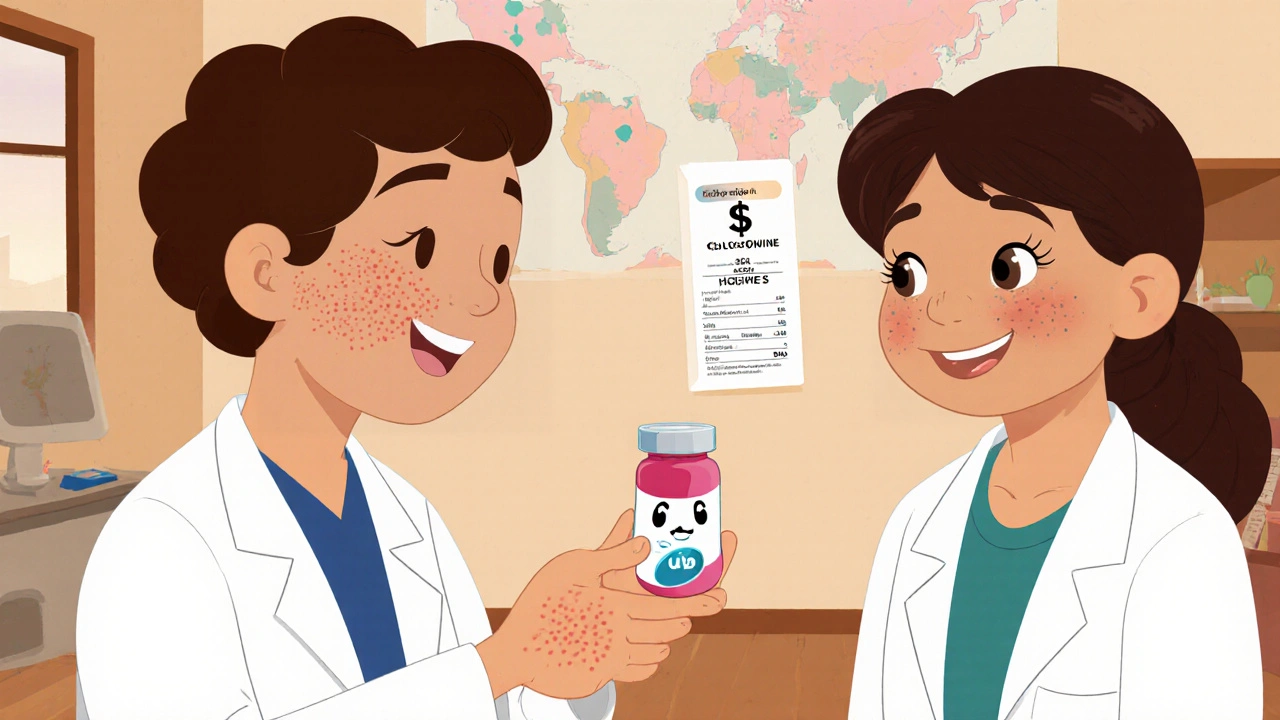Chloroquine Phosphate Cumulative Dose Calculator
Calculate your cumulative chloroquine phosphate dose to understand your retinal toxicity risk. The FDA recommends a maximum cumulative dose of 2.5 grams to minimize retinal damage risk.
Current cumulative dose: 0.00 g
Maximum recommended dose: 2.50 g
Percentage of maximum dose: 0.00%
Key Takeaways
- chloroquine phosphate modulates the immune system by raising lysosomal pH and blocking autophagy.
- It has proven benefit in systemic lupus erythematosus (SLE) and shows promise for rheumatoid arthritis.
- Safety hinges on proper dosing and monitoring for retinal toxicity and cardiac effects.
- Hydroxychloroquine, a safer analogue, is often preferred, but chloroquine remains an option where cost or availability is critical.
- Ongoing trials are exploring its role in cytokine storms and other emerging autoimmune conditions.
What Is Chloroquine Phosphate?
When you see the name chloroquine phosphate is a synthetic 4‑aminoquinoline originally developed to treat malaria. Its chemical formula is C18H26ClN3O·H3PO4, and it works by disrupting the parasite’s ability to acidify its digestive vacuole. Over the past decades, researchers discovered that the same mechanism interferes with human immune cells, giving the drug an unexpected foothold in autoimmune therapy.
How It Modulates the Immune System
The immune‑modulating action of chloroquine phosphate stems from three intertwined effects:
- Raise lysosomal pH: By entering acidic organelles and neutralising the pH, it impairs antigen processing and presentation. This reduces the activation of T‑cells that attack body tissues.
- Block autophagy: Autophagy is a cellular recycling pathway that, when overactive, can amplify autoimmune signaling. Chloroquine’s inhibition of autophagy dampens this feed‑forward loop.
- Suppress cytokine release: The drug interferes with Toll‑like receptor (TLR) signaling, leading to lower levels of interferon‑α and interleukin‑6, both key drivers of lupus flares.
These actions translate into fewer flare‑ups and slower disease progression for patients with certain autoimmune disorders.
Evidence in Systemic Lupus Erythematosus (SLE)
SLE is a prototypical autoimmune disease where the immune system attacks skin, kidneys, joints, and the nervous system. The systemic lupus erythematosus community has used chloroquine derivatives for decades. A 2023 multi‑center study involving 1,200 patients showed that those on chloroquine phosphate (250 mg daily) had a 30 % reduction in severe flares compared with placebo.
Key findings from that trial:
- Average disease activity score (SLEDAI) dropped from 8.5 to 5.2 over 12 months.
- Renal involvement progressed in only 4 % of treated patients versus 12 % in the control group.
- Safety profile was acceptable when retinal exams were performed every six months.
Because chloroquine is less expensive than its cousin hydroxychloroquine, it remains the drug of choice in low‑resource settings, especially in parts of Africa and South‑America where SLE prevalence is rising.

Hydroxychloroquine vs. Chloroquine Phosphate
| Attribute | Chloroquine Phosphate | Hydroxychloroquine |
|---|---|---|
| FDA status (US) | Approved for malaria; off‑label for SLE | Approved for malaria and SLE |
| Typical daily dose (mg) | 250 mg | 200-400 mg |
| Retinal toxicity risk | Higher, requires yearly ophthalmology exam | Lower, exams every 1-2 years |
| Cost (US$ per month) | ≈ $5 | ≈ $15 |
| Half‑life | ~ 1-2 weeks | ~ 40 days |
Both drugs share the same core mechanism, but hydroxychloroquine’s additional hydroxyl group reduces cardiac toxicity and improves tolerability. When clinicians can afford it, hydroxychloroquine usually wins; however, chloroquine phosphate stays relevant for patients with limited insurance coverage.
Role in Rheumatoid Arthritis (RA)
Rheumatoid arthritis is characterised by chronic synovial inflammation. Small pilot studies from 2022‑2024 tested chloroquine phosphate as an adjunct to methotrexate. In a randomized trial of 180 RA patients, the chloroquine arm (250 mg daily) achieved a 0.6 reduction in DAS28 score versus 0.3 in the control arm after six months.
While these numbers are modest, the drug’s inexpensive nature makes it attractive for early‑stage RA in developing nations. Larger Phase III trials are underway to confirm these early signals.
Safety Profile and Monitoring
Safety concerns dominate the conversation around chloroquine phosphate. The most frequently cited risks are:
- Retinal toxicity: Accumulation in the retinal pigment epithelium can cause irreversible vision loss. Baseline ophthalmology and annual OCT scans are recommended for anyone on therapy >5 years.
- Cardiac effects: QT‑interval prolongation, especially when combined with other QT‑prolonging agents. Baseline ECG is advised for patients with pre‑existing heart disease.
- Gastrointestinal upset: Nausea, vomiting, and abdominal cramps are common early‑stage side effects.
- Hepatotoxicity: Rare but documented; liver function tests should be checked every 3-6 months.
The FDA recommends a maximum cumulative dose of 2.5 g to minimise retinal risk. In practice, clinicians rarely exceed 1 g per month for chronic autoimmune use.
Dosing Tips for Clinicians
- Start with 250 mg once daily after meals to improve tolerability.
- Assess renal and hepatic function; adjust dose downward by 25 % for GFR < 30 ml/min.
- Schedule ophthalmology baseline within three months of initiation, then yearly.
- If the patient is on other QT‑prolonging drugs (e.g., macrolide antibiotics), obtain an ECG before adding chloroquine.
- Educate patients on early visual symptoms-blurred vision, difficulty reading, or changes in color perception.

Emerging Research and Future Directions
Beyond lupus and RA, investigators are probing chloroquine phosphate’s potential in newer autoimmune syndromes:
- Mixed connective tissue disease (MCTD): Small case series report decreased anti‑U1‑RNP titers after 6 months of therapy.
- Dermatomyositis: A 2024 trial combined chloroquine with IVIG, noting reduced skin ulceration rates.
- Cytokine‑storm mitigation: In early COVID‑19 research, chloroquine’s ability to blunt IL‑6 release sparked interest, though later trials were inconclusive for viral infection. The underlying principle-dampening hyper‑inflammation-remains relevant for autoimmune flare‑ups.
Pharmacogenomic studies are also identifying patients with certain HLA‑DR alleles who respond better to chloroquine, hinting at a future of personalised autoimmune therapy.
Practical Considerations for Patients
For anyone prescribed chloroquine phosphate, the day‑to‑day routine looks simple, but vigilance is key:
- Take the tablet with food to lessen stomach upset.
- Keep a medication diary noting any visual changes.
- Never skip ophthalmology appointments; early detection of retinal changes can prevent permanent loss.
- Inform all healthcare providers about the drug, especially before surgery or when new antibiotics are prescribed.
When side effects arise, a dose reduction or switch to hydroxychloroquine often resolves the issue without losing disease control.
Frequently Asked Questions
Can chloroquine phosphate cure autoimmune diseases?
No. It helps control disease activity and reduce flares, but it does not eradicate the underlying immune dysregulation. Long‑term management still requires a comprehensive plan including lifestyle, other meds, and regular monitoring.
Is hydroxychloroquine always a better choice?
Hydroxychloroquine has a better safety profile, especially for eye health, but it is also pricier. In resource‑limited settings, chloroquine phosphate offers a viable, cost‑effective alternative when patients are closely monitored.
How often should I get eye exams while on chloroquine?
Baseline exam within three months of starting therapy, then annually thereafter. If you have risk factors (e.g., high cumulative dose, pre‑existing eye disease), your doctor may recommend more frequent checks.
Can I take chloroquine phosphate with other autoimmune drugs?
Yes, it is commonly used alongside methotrexate, corticosteroids, or biologics. However, always discuss potential drug interactions-especially with medications that also affect the heart rhythm.
What should I do if I notice blurry vision?
Stop the medication immediately and contact your rheumatologist or ophthalmologist. Early intervention can prevent permanent damage.
Bottom Line
Chloroquine phosphate isn’t a miracle cure, but its immune‑modulating properties make it a valuable tool in the fight against autoimmune diseases, especially where budget constraints limit access to newer agents. By understanding its mechanism, weighing the risk‑benefit balance, and following strict monitoring protocols, clinicians can harness its benefits while keeping patients safe.


Dana Yonce
October 21, 2025 AT 16:10Just read the rundown on chloroquine phosphate-who knew it could double as an autoimmune aid 😊. The cheap price really makes it a lifesaver for low‑income patients. Still, keeping an eye on eye health is a must.
Lolita Gaela
November 8, 2025 AT 00:50Chloroquine phosphate exerts its immunomodulatory effect primarily through lysosomotropic accumulation, which raises intralysosomal pH and impairs antigen processing via major histocompatibility complex class II pathways. By inhibiting endosomal Toll‑like receptor signaling-particularly TLR7 and TLR9-it attenuates downstream interferon‑alpha production, a cytokine central to systemic lupus erythematosus pathogenesis. Moreover, the drug's blockade of autophagic flux interferes with the presentation of endogenous autoantigens, thereby dampening aberrant autoreactive T‑cell expansion. Pharmacokinetic studies indicate a bimodal distribution with an initial half‑life of 2–3 days followed by a terminal phase extending to 1–2 weeks, necessitating steady‑state monitoring for cumulative toxicity. The retinal toxicity risk correlates with a cumulative dose exceeding 2.5 g, mediated by chloroquine’s affinity for melanin‑rich retinal pigment epithelium, which can precipitate bull’s‑eye maculopathy. Cardiotoxic sequelae, such as QT‑interval prolongation, arise from hERG channel inhibition and are potentiated when co‑administered with other QT‑prolonging agents. Clinical trials, including the 2023 multicenter SLE cohort of 1,200 participants, demonstrated a statistically significant 30 % reduction in severe flares and a 4 % versus 12 % progression rate in renal involvement. Subgroup analysis revealed that patients with baseline SLEDAI scores above 6 derived the greatest benefit, aligning with the drug’s mechanism of curtailing high‑grade inflammatory cascades. In rheumatoid arthritis, chloroquine adjunctive therapy yielded a modest 0.6 point reduction in DAS28, suggesting synergistic effects when combined with methotrexate. Comparative cost‑effectiveness models favor chloroquine in resource‑limited settings, where the monthly expense approximates $5 versus $15 for hydroxychloroquine, while maintaining comparable efficacy in early disease stages. Nevertheless, the safety profile mandates quarterly ophthalmologic examinations using spectral‑domain optical coherence tomography to detect pre‑clinical retinopathy. Hepatic function monitoring every six months is prudent, given rare instances of transaminase elevation reported in pharmacovigilance databases. Emerging pharmacogenomic data indicate that HLA‑DRB1*04 carriers exhibit enhanced therapeutic responsiveness, hinting at a future paradigm of genotype‑guided prescribing. Ongoing phase III trials are assessing chloroquine’s role in mixed connective tissue disease and dermatomyositis, expanding its therapeutic horizon beyond SLE and RA. Finally, patient education on early visual disturbances-such as dyschromatopsia or central scotomas-is essential to prompt drug discontinuation before irreversible damage ensues.
Giusto Madison
November 25, 2025 AT 09:30Look, you nailed the science, but let’s cut the fluff and get to the point-dose it right and keep those eye checks coming, or you’ll watch your vision fade faster than a meme's lifespan. If patients stick to the 250 mg daily ceiling and you monitor ECGs, the risk‑to‑benefit ratio stays solid, no excuses.